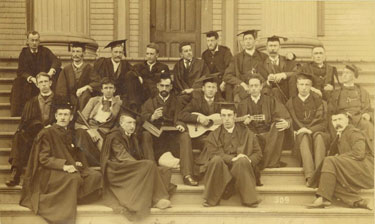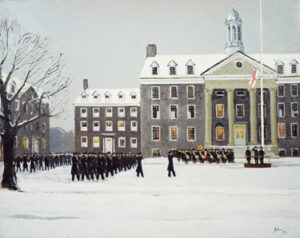 Anglican Loyalists who moved to Nova Scotia in the wake of the Revolution, some among them with strong connections to the old King’s, founded the new King’s College in Windsor. The college then received its Royal Charter from King George III in 1802, which stated that King’s was to be “a College for the education of Youth in the Principles of true religion and for their instruction in the different branches of Science and Literature which are taught at our Universities in this Kingdom.” From the beginning, the University of King’s College was closely aligned with the Church of England, reflecting the political and religious principles of its Loyalist founders, however, a divinity school as a distinct entity was not established until the 1880s, and the first appearance of the School of Divinity by a formal name was not until 1936.
Anglican Loyalists who moved to Nova Scotia in the wake of the Revolution, some among them with strong connections to the old King’s, founded the new King’s College in Windsor. The college then received its Royal Charter from King George III in 1802, which stated that King’s was to be “a College for the education of Youth in the Principles of true religion and for their instruction in the different branches of Science and Literature which are taught at our Universities in this Kingdom.” From the beginning, the University of King’s College was closely aligned with the Church of England, reflecting the political and religious principles of its Loyalist founders, however, a divinity school as a distinct entity was not established until the 1880s, and the first appearance of the School of Divinity by a formal name was not until 1936.
The Calendar of 1896-1897 stated that the University conferred degrees in arts, divinity (Bachelor of Divinity and Doctor of Divinity), law, engineering, science and literature, and medicine. “There are at present in the University seven schools open to matriculated students: The School of Arts, the School of Divinity, the School of Engineering, the School of Science, the School of Law, the School of Literature, and the School of Medicine.”
King’s remained in Windsor until 1920 when a fire ravaged the campus, burning its main building to the ground and raising the question of how or if the college was to survive.
King’s was determined to carry on, and so accepted the terms of a generous grant from the Carnegie Corporation of New York to rebuild, not in Windsor but in Halifax, the capital city of Nova Scotia, entering into association with Dalhousie University. Under this agreement, King’s agreed to pay the salaries of a number of Dalhousie professors, who in turn would help in the management and academic life of King’s College. Students at King’s would also study at Dalhousie and have access to all of the amenities of the larger school, and the academic programs at King’s (except for Divinity) would fold into the College of Arts and Sciences at Dalhousie.
 From 1941 to 1945, the college’s buildings became His Majesty’s Canadian Ship, HMCS Kings, where officers were trained for the Royal Canadian Navy. The academic life of the college carried on during those years elsewhere in Halifax, aided by Dalhousie University and the United Church’s Pine Hill Divinity Hall.
From 1941 to 1945, the college’s buildings became His Majesty’s Canadian Ship, HMCS Kings, where officers were trained for the Royal Canadian Navy. The academic life of the college carried on during those years elsewhere in Halifax, aided by Dalhousie University and the United Church’s Pine Hill Divinity Hall.
The face of King’s changed dramatically during the 1970s. The King’s Faculty of Divinity became part of the Atlantic School of Theology (AST) in 1971. King’s retained its degree-granting powers in divinity until 1974, when AST was incorporated by An Act to Incorporate Atlantic School of Theology (1974), which granted AST the power to confer degrees in its own name and in its own right. At the same time as divinity studies were being relocated, two new King’s projects were underway. In 1972, the college introduced its unique Foundation Year Program, and in 1978, it established the only degree-granting school of journalism in Atlantic Canada. This was the beginning of a long period of academic innovation and a shift of the college toward a national profile.
King’s is now well into its third century—and the changes have continued. Three interdisciplinary honours programs have been developed with cooperation from King’s and Dalhousie faculty: the Contemporary Studies Program (1993), the Early Modern Studies Program (1999) and the History of Science and Technology Program (2000). The School of Journalism, Writing & Publishing has three programs offered at the graduate level: A Master of Journalism, a Master of Fine Arts in Creative Nonfiction and a Master of Fine Arts in Fiction.
King’s Traditions
Traditions Lecture [PDF] by Henry Roper
Past chancellors and presidents of the college
Chancellors:
The Very Rev. Edwin Gilpin, DD, DCL, 1891-1897
Edward Jarvis Hodgson, DCL, 1897-1911
Sir Charles J. Townshend, DCL, 1912-1922
The Most Rev. John Hackenley, DD, 1937-1943
The Hon. Ray Lawson, OBE, LLD, DCnL., DCL, 1948-1956
Lionel Avard Forsyth, QC, DCL, 1956-1958
H. Ray Milner, QC, DCnL, DCL, LLD, 1958-1963
Robert H. Morris, MC, BA, MD, FACS, 1964-1969
Norman H. Gosse, MD, CM, DSc, DCL, LLD, FACS, FRCS(C), 1971-1972
The Honourable Mr. Justice R.A. Ritchie, DCL, LLD, 1974-1988
G. Hamilton Southam, OC, BA, LLD, LLD, DCL, DU, 1988-1996
The Honourable J. Trevor Eyton, OC, QC, BA, LLB, LLD, 1996-2001
The Honourable Michael Arthur Meighen, QC, BA, LLL, LLD 2001-2013
The Honourable Kevin Lynch, PC, OC, LLD, 2013-2018
Debra Deane Little, 2020-present
Presidents and vice-chancellors:
The Rev. Dr. William Cochran, 1789-1804
The Rev. Thomas Cox, 1804-1805
The Rev. Dr. Charles Porter, 1805-1836
The Rev. Dr. George McCawley, 1836-1875
The Rev. Dr. John Dart, 1875-1885
The Rev. Dr. Isaac Brock, 1885-1889
The Rev. Dr. Charles Willets, 1889-1904
Dr. Ian Hannah, 1904-1906
The Rev. Dr. C.J. Boulden, 1906-1909
The Rev. Dr. T.W. Powell, 1909-1914
The Rev. Dr. Charles E. Willets, (Acting), 1914-1916
The Rev. Dr. T.S. Boyle, 1916-1924
The Rev. Dr. A.H. Moore, 1924-1937
The Rev. Dr. A. Stanley Walker, 1937-1953
The Rev. Dr. H.L. Puxley, 1954-1963
Dr. H.D. Smith, 1963-1969
Dr. F. Hilton Page, (Acting), 1969-1970
Dr. J. Graham Morgan, 1970-1977
Dr. John F. Godfrey, 1977-1987
Dr. Marion G. Fry, 1987-1993
Dr. Colin J. Starnes, 1993-2003
Dr. William W. Barker, 2003-2011
Dr. Anne Leavitt, 2011 2012
Dr. George Cooper, 2012-2016
Professor William Lahey, 2016-present
Thanks to the University Archives for providing the above historical photos, the first depicting a campus view in 1928, the second, a group of students on the steps of the Windsor campus main building in 1888 and the third, a painting by artist Anthony Law of HMCS King’s during WWII.